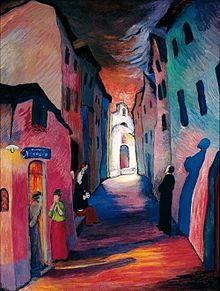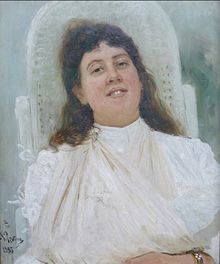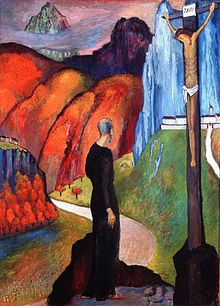Ernst Alfred Aye

Ernst Alfred Aye , alias Santo , (* 1878 in Berlin ; † January 16, 1947 in Diekhof , Rostock district in Mecklenburg ) was a German concert singer , the longtime companion, administrator and partial heir of the painter Marianne von Werefkin and son of a "former court preacher in Dresden ".
Life
Aye, Werefkin's accomplice in art
Aye first saw paintings by the Russian painter Marianne von Werefkin in Dresden's Neue Kunst Fides gallery in 1925 , which made a great impression on him. In the same year he was to get to know the artist in her Swiss exile in Ascona on Lake Maggiore . This encounter essentially determined his further life.
After Jawlensky left Baroness Werefkin in 1921, she suffered terribly and was unable to paint. She only got over her pain when she met Aye, with whom she shared a deep friendship until her death. Werefkin met Aye in 1925 as a tourist on the Asconeser Piazza and wrote in her diary: “And the miracle happened, I actually see and meet him, […] my type, my Santo. I meet him [...] the moment I was dead and blind, [...] God what luck! My living Santo stands before me. He thinks the old woman has gone crazy, but that is unimportant [...] I became a painter again. "With Santo, Werefkin gained new strength and was able to give her old work new contours:" I work a lot with the warm rays of love and friendship Santos. It is my consolation, it is what I have been looking for all my life without finding it. He came in the last hour ”. She immortalized him in pictures and on the wall of her Ascones studio.
In her diary, the Werefkin wrote about her relationship with Aye: “Santo is not a great art connoisseur, but he loves my pictures like a piece of myself. He lives from them and with them, they are dearest to him. And this makes him my greatest accomplice in art as well as in life. He keeps my faith in my goals awake, he strengthens my joy in what I have achieved, he keeps me youthful and my thanks to him are unlimited. "
Traveling with Aye in Italy
For “late June 1914” Jawlensky reports in his memoirs: “We had planned to go to Italy.” Only from the often overlooked, short remark in his memoirs one learns of a joint project of the artist couple Werefkin / Jawlensky, the First World War foiled. Werefkin's long-cherished wish to get to know Italy's art treasures in the original, which she knew so well from her studies, was not fulfilled until 1925 - when accompanied by the Santo she canonized .
Financially, she made such a trip possible for two reasons. On the one hand, Jawlensky had dated “26. February 1925 ”sent from Wiesbaden “ Fr. 4,000 .-- as part of the picture Van Gogh sold ”. On the other hand, Pope Pius XI. As is customary every 25 years in modern times , the Holy Year is proclaimed and the Holy Door of St. Peter's Basilica is opened. “Pilgrim cards”, with which one could travel by train all over Italy at reduced prices - and stay the night in cheap quarters - the railways became cheap like trams - also enabled poor people to make a pilgrimage to Rome . Werefkin and her Santo took advantage of the opportunity.
As an emigrant with a Nansen passport , however, Werefkin could not go abroad. Courageously, she wrote to the Duce and received the required papers. Accompanied by her Santo, she then traveled through Italy. On the way, she not only made sketches, some of which she later processed into paintings, but also kept a diary, which she called “Letters”, which was printed as a continuation in the Neue Zürcher Zeitung in 1925 . In addition to personal experiences, she also put interesting thoughts on the art and history of Italy on paper.
The path led the unequal couple to the cities of Milan , Bologna , Rome , Naples , Pompeii , Ischia , Naples, Ischia, Assisi , Perugia , Siena and Arezzo . Completely different than usual, e.g. B. Described in Baedeker , it illustrated what she and Aye experienced. Bologna z. B. described it as “a cubist city, where the lines, the surfaces, the volumes and the soul enchant by themselves. The towers cut and cross each other and throw the cubist principle into the sky. ”Only by visiting Rome could Aye and Werefkin obtain the pilgrimage privileges of the time :“ Our pilgrimage cards had to be stamped in Rome. So we had to go to Rome. So we were in Rome for three days and didn't see the Pope, neither the Vatican nor the museums, but we saw and enjoyed Rome. Rome, ancient Rome, mistress of the world, Rome the martyr, Rome the triumphant. […] The historically educated traveler has to toil a lot. Millennia stare at him; now from marble fragments, now from colossal architectural structures. Everywhere he has to know: this happened here, that there. An emperor, a pope, a people, a genius have left their footprints here. Cook and Son ease this torment for those who submit to it. [...] Everywhere, inside and outside, you can hear purring voices, listening to international ears telling the history of Rome. "
Werefkin's administrator
From 1926/27 to 1932 Aye lived as a concert singer in Dresden at Comeniusstraße 27. Through an exchange of letters with the art historian Hans Hildebrandt and his wife, the glass painter Lily Hildebrandt , one learns that Aye has been managing "all matters" for Werefkin since 1927 as administrator. In 1932 Aye moved to Berlin and lived in the right wing of Charlottenburg Palace . At that time, Werefkin counted “Mr. Aye in Berlin” in her “autobiographical sketch” among those people who “have larger collections of my things”.
In 1935 the writer Wilhelm Schmidtbonn offered to write a book about Werefkin's life and work. When the company failed, Aye and Diego Hagmann, Werefkin's Zurich patrons, planned to publish a portfolio of color and monochrome reproductions of several paintings by the Werefkin. This project also failed.
Werefkin's heirs

Along with Alexander Werefkin (1904–1982), Aye was the main heir to the painter's artistic estate. Aye donated his share to Fritz Stöckli (1903–1970), who in 1939 founded the Fondazione Marianne Werefkin . As early as 1932 Werefkin had decreed that the painting “Portrait of Marianne Werefkin” in the rocking chair by Ilya Yefimowitsch Repin , which he painted by the artist in 1888 after her hunting accident, should inherit. At that time, the painting was already in Sinzig , one of the residences of Alexander Werefkin. It was then sent to Aye in Berlin in 1933. Aye "bequeathed" the picture to a Werefkin admirer named Klücher in Eutin , who took it with him when he moved to Bremen . After the death of her husband, Ms. Klücher showed no interest in the Repin picture, “which had a crack.” She “handed it over to Hans Keller (1913–2007), curator of the Kunsthalle Bremen .” He had it “put in order "And sent the painting" to the best expert on the subject, Dr. Weiler ”, which should check the authorship of the painter and the possible identity of the sitter. In the course of his research, Weiler managed to acquire the painting for the Wiesbaden Museum .
At the end of the Second World War
Aye was forced to leave Berlin as a result of the increasing air raids . On November 23, 1943, the Charlottenburg Palace was badly damaged by bombs, so that he could not return to his apartment. After moving several times, he finally moved to Diekhof , a municipality in the Rostock district in Mecklenburg, in late autumn . Only a report by an otherwise anonymous Rosa Harnisch informs about the last days and the date of death of First Alfred Aye : “He went from door to door, always asking in vain, because everyone had to do with himself and was afraid of starving to death the coming winter . So he came to me and pleaded that I should take him in. I gave him a room. His condition became so bad in 1946 that he could no longer move his limbs. This good, dear person had a sad end. On January 13, 1947, the refugee commission came. Aye had to vacate the room for a family. He himself came to the hospital, he was driven there in an open wagon with straw. He died there on the 16th and was buried without a coffin ”.
Individual evidence
- ^ Brigitte Roßbeck: Marianne von Werefkin. The Russian from the Blue Rider's circle. Munich 2010, p. 215, note 32
- ^ A b Brigitte Roßbeck: Marianne von Werefkin. The Russian from the Blue Rider's circle. Munich 2010, p. 216, note 34
- ↑ a b Alexander von Werefkin to “Herr Doktor Keller”, November 21, 1957, Archive Fondazione Marianne Werefkin, Ascona
- ↑ The Cicerone . XVII, year 1925, p. 151
- ↑ Bernd Fäthke: Marianne Werefkin. Munich 2001, p. 202
- ↑ Bernd Fäthke: Marianne Werefkin. Munich 2001, Fig. 231–232, pp. 206–207; Fig. 249, p. 227
- ↑ Bernd Fäthke: Marianne Werefkin. Munich 2001, p. 205
- ↑ Alexej Jawlensky: Memoirs. In: Clemens Weiler (Ed.): Alexej Jawlensky, Heads-Faces-Meditations . Hanau 1970, p. 115
- ↑ Bernd Fäthke: Jawlensky and his companions in a new light. Munich 2004, p. 190 f., Referring to the painting “Street in Auvers (The House of Père Pilon)” from 1890
- ↑ Bernd Fäthke: Marianne Werefkin. Munich 2001, p. 208, doc. 14
- ^ Archives Fondazione Marianne Werefkin, Ascona
- ^ Neue Zürcher Zeitung, 1925, Archive Fondazione Marianne Werefkin, Ascona
- ^ Brigitte Roßbeck: Marianne von Werefkin. The Russian from the Blue Rider's circle. Munich 2010, note 35
- ^ Brigitte Roßbeck: Marianne von Werefkin. The Russian from the Blue Rider's circle. Munich 2010, p. 217
- ^ Marianne von Werefkin: Autobiographical sketch . In: Konrad Federer (Ed.): Marianne von Werefkin, testimony and image . Zurich 1975, p. 11
- ↑ See: Bernd Fäthke: Marianne Werefkin. Munich 2001, p. 236, Fig. 258 and Fig. 259
- ^ Brigitte Roßbeck: Marianne von Werefkin. The Russian from the Blue Rider's circle. Munich 2010, p. 232
- ^ Marianne Werefkin's nephew
- ↑ Bernd Fäthke: Marianne Werefkin. Munich 2001, p. 243, fig. 263
- ↑ Today in the Wiesbaden Museum
- ↑ Clemens Weiler , former director of the Wiesbaden Museum and first Jawlensky biographer
- ↑ Dr. Hans Keller, curator of the Kunsthalle Bremen, letter to attorney Dr. Loske, Sinzig, November 24, 1958
- ^ Brigitte Roßbeck: Marianne von Werefkin. The Russian from the Blue Rider's circle. Munich 2010, p. 247 f. and note 8
| personal data | |
|---|---|
| SURNAME | Aye, Ernst Alfred |
| BRIEF DESCRIPTION | German concert singer |
| DATE OF BIRTH | 1878 |
| PLACE OF BIRTH | Berlin |
| DATE OF DEATH | January 16, 1947 |
| Place of death | Diekhof , Rostock district , Mecklenburg-Western Pomerania |
